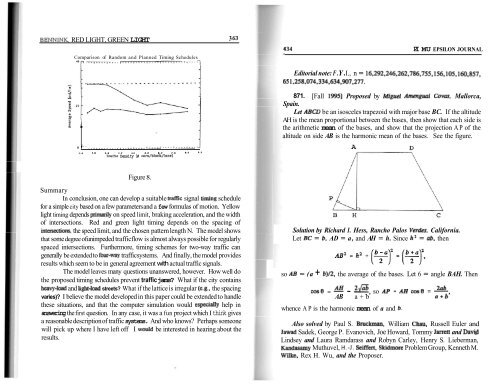Vol. 10 No 5 - Pi Mu Epsilon
Vol. 10 No 5 - Pi Mu Epsilon
Vol. 10 No 5 - Pi Mu Epsilon
Create successful ePaper yourself
Turn your PDF publications into a flip-book with our unique Google optimized e-Paper software.
BENNINK, RED LIGHT, GREEN LIGHT 3 63 0 tComparison of Random and Planned Timing Schedulese o , , ,,,,,,,,,,,,, l # , , , , , , L , l , . , ~ 1 8 ~ a ~ , 4 ~ ~ ~ , . . . .",,,,,,, ,,%, ,,,,,,,,, !,,,., ,,,,,,,,,.,. 1C.0 1.0 2.0 3.0 4.0 2.0 e.0 7.0 ç. E.0Trefiic Density (# cers/block/lene)434 PI MU EPSILON JOURNALEditorial note: F. Y. I., n = l6,292,246,262,786,755,l56,lO5,l6O,857,651,258,074,334,634,907,277.871. [Fall 19951 Proposed by Miguel Amengual Covas. Mallorca,Spain.Let ABCD be an isosceles trapezoid with major base BC. If the altitudeAH is the mean proportional between the bases, then show that each side isthe arithmetic mean of the bases, and show that the projection AP of thealtitude on side AB is the harmonic mean of the bases. See the figure.Figure 8.SummaryIn conclusion, one can develop a suitable traffic signal timing schedulefor a simple city based on a few parameters and a few formulas of motion. Yellowlight timing depends pnmanly on speed limit, braking acceleration, and the widthof intersections. Red and green light timing depends on the spacing ofintersections, the speed limit, and the chosen pattern length N. The model showsthat some degree ofunimpeded traffic flow is almost always possible for regularlyspaced intersections. Furthermore, timing schemes for two-way traffic cangenerally be extended to four-way traffic systems. And finally, the model providesresults which seem to be in general agreement with actual traffic signals.The model leaves many questions unanswered, however. How well dothe proposed timing schedules prevent traffic jams? What if the city containsheavy-load and light-load streets? What if the lattice is irregular (e.g., the spacingvaries)? I believe the model developed in this paper could be extended to handlethese situations, and that the computer simulation would especially help inanswering the first question. In any case, it was a fun project which I think givesa reasonable description of traffic systems. And who knows? Perhaps someonewill pick up where I have left off I would be interested in hearing about theresults.Solution by Richard I. Hess, Rancho Palos Verdes, California.Let BC = b, AD = a, and AH = h. Since h2 = ab, thenso AS = (a + b)/2, the average of the bases. Let 6 = angle BAH. ThenAH - 2@, so AP = AH cos6 = -labAB a+b a+bycos6 = - - -whence AP is the harmonic mean of a and b.Also solved by Paul S. Bruckman, William Chau, Russell Euler andJawad Sadek, George P. Evanovich, Joe Howard, Tommy Jarrett and DavidLindsey and Laura Ramdarass and Robyn Carley, Henry S. Lieberman,Kandasamy <strong>Mu</strong>thuvel, H.-J. Seiffen, Skidmore Problem Group, Kenneth M.Wilke, Rex H. Wu, and the Proposer.
















